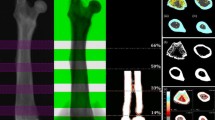Abstract
This study was designed to assess the precision and accuracy of newly developed ultra high resolution mode (rat mode) in DXA (Hologic, QDR-1000), determine how body thickness affects measured BMD values and to derive a formula by which BMDs in animals with varying degrees of body thickness can be compared. The long term reproducibility on two phantoms (BMD: 170 and 300 mg/cm2) were under CV 1.0%. The repeated precision in vivo and in vitro lumbar spines and phantoms were within CV 1.5%. Accuracy was evaluated by determining the correlation coefficient between ash weight and tibial BMC. The correlation was excellent (r=0.999, p<0.001) over the ash range of 250–600 mg. Using single regression equations, QDR-1000 BMC values were compared with those obtained by conventional methods. There was a close linear correlation with both SPA (Norland Co., r=0.997) and DCS-600 (Aloka Co., r=0.996) measurements. The effects of body thickness were assessed by immersing phantoms at various water depths. There was a significant linear decrease in BMD, as measured by QDR-1000, with increasing water depth. BMDs in vivo with varying body thickness can be compared with each other by using the following correcting formula: BMD1=(BMD2+5.5w+7.6) × 103/(977-4.8w), where BMD1=expected BMD of extracted bone (mg/cm2), BMD2=BMD in vivo (mg/cm2), w=body thickness (cm). There was a significant positive correlation (r=0.996, p<0.001) between calculated BMDs from this equation and the values actually obtained. These results confirm that QDR-1000 rat mode yields data useful for assessing BMD and BMC in small animal bones.
Similar content being viewed by others
References
Johnston, C.C., Slemenda, C.W. and Melton. L.J.: Clinical use of bone densitometry. New Engl. J Med. 324: 1105–1109, 1191
Cruess, R.L. and Hong, K.C.: The effect of long term estrogen administation on bone metabolism in the female rat. Endocrinology 104: 1188–1193, 1979
Yamazaki, I and Yamaguchi, I.H.: Caractristics of an ovariectomezed osteopenic rat model. J. Bone Miner. Res. 4: 13–22, 1989
Sanchez, T.V., Myers, R.C., Bond, J.T. and Mayor, G.H.: Bone mineral analysis of the rat femur by direct photon absorptimetry. Calcif. Tissue Int. 33: 587–590, 1981
Glüer, C.C., Steiger, P., Selvidge, R., Elliesen-Kleiefoth, K.E., Hayashi, C. and Genant H.K.: Comparative assessment of dual-energy radiography. Radiology. 174: 223–228, 1990
Wahner, H.W., Dunn, W.L., Brown, M.L., Morin, R. and Riggs, B.L.: Comparison of dual energy absorptiometry and dual photon absorptiometry for bone mineral measurements of the lumbar spine. Mayo Clin. Proc. 63: 1075–1084, 1988
Fischer, G.L., Schwind, J.A., Lee, T.D. and Goldman, M.: A photon absorptiometer for in vivo and in vitro measurement of small animal bone density. Biomed. Eng. 9: 196–199, 1974
Nakatsuka, K., Nishizawa, Y., Hagiwara, S., Koyama, H., Miki, T., Ochi, H. and Morii, H.: Effect of calcitonin on total body bone mineral contents of experimental osteoporotic rats determined by dual photon absorptiometry. Calcif. Tissue Int. 47: 378–382, 1990
Kimmel, D.B. and Wronski, T.J.: Nondestructive measurement of bone mineral in femurs fro n ovariectomized rats. Calcif. Tissue Int. 46: 101–110, 1990
White, D.R., Martin, R.J. and Darlison R.: Epoxy resin based tissue substitutes. Br. J. Radiol. 50: 814–821, 1977
Cullum, I.D., Ell, P.J. and Ryder, J.P.: X-ray dual-photon absorptiometry: a new method for the measurement of bone density. Br. J. Radiol. 62, 587–592, 1989.
Tomomitsu, T., Fukunaga, M., Otsuka, N., Ono, S., Nagai, K., Morita, K., Furukawa, T., Muranaka, A., Yanagimoto, S., Tamegai, T., Kawamura, K, and Morita, R.: Clinical usefulness for dual photon absorptiometry system using x-ray for peripheral bone, -comparison to single photon absorptiometric system- Radioisotopes 37, 521–524, 1988.
Author information
Authors and Affiliations
About this article
Cite this article
Igarashi, C., Ezawa, I. Fundamental evaluation of dual x-ray absorptiometry (DXA) for measurement of bone mineral density in rats. J Bone Miner Metab 11, 23–29 (1993). https://doi.org/10.1007/BF02383530
Issue Date:
DOI: https://doi.org/10.1007/BF02383530




